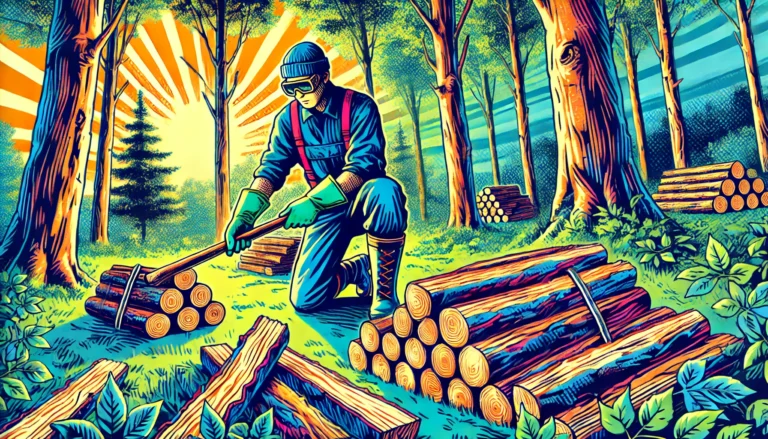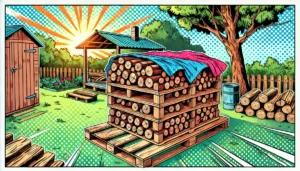Table of contents
Introduction
Collecting firewood can be a rewarding way to save money, stay warm, and enjoy the great outdoors. However, following legal tips for collecting firewood is essential to avoid fines, protect the environment, and ensure your own safety. It’s not as simple as picking up branches or chopping down trees—you need to know the rules and be prepared.
Here’s what we’ll cover:
- Legal tips for collecting firewood: Learn how to avoid fines and collect firewood the right way. Whether you’re in the US or the UK, rules can vary, and it’s important to understand what’s allowed.
- Safety advice: Stay safe by using the right gear and being aware of potential hazards while collecting firewood.
By following these legal and safety tips for collecting firewood, your journey will be smooth, efficient, and most importantly, responsible.
Understanding Legal Tips for Collecting Firewood
When it comes to collecting firewood, knowing the rules is half the battle. Every country—and sometimes even regions within countries—has its own set of laws governing where, how, and when you can gather wood. Let’s explore the legal tips for collecting firewood to ensure you’re following the rules and staying safe:
Land Ownership Rules
- Private Land: Always ask for permission before collecting wood on private property. Fines and awkward conversations with landowners aren’t worth the hassle.
- Public Land: Some areas, like public forests or parks, might allow firewood collection—but rules vary. Always check the specific location’s regulations before you start.
USA vs. UK Laws
- In the USA:
- Public lands, like those managed by the Bureau of Land Management (BLM), often allow firewood collection with a permit. These permits are typically affordable and easy to obtain.
- Moving firewood between states? That’s prohibited in many places due to strict rules designed to prevent pests and diseases. Always double-check the local guidelines.
- In the UK:
- Most land is privately owned, so you’ll need explicit permission to collect wood. Even picking up fallen branches without consent could lead to trouble.
- National Trust and conservation areas usually prohibit firewood collection to protect wildlife. Some local councils may have designated areas for collection—check beforehand to be sure.
Staying Within Legal Limits
- Volume Restrictions: Many regions have rules about how much wood you can collect at once. Staying within these limits helps you avoid fines.
- Seasonal Guidelines: Firewood collection might only be allowed during certain seasons to minimize environmental impact. For instance, spring restrictions may protect nesting animals.
- Restricted Zones: Conservation zones, wildlife reserves, or protected lands are typically off-limits. Always stick to areas where collection is explicitly permitted.
By following these legal tips for collecting firewood and respecting boundaries, you can collect firewood confidently and responsibly without stepping on any toes—or breaking any laws!
Looking for an easy way to find free or affordable firewood near you? Check out our guide with a handy API tool to locate local firewood sources: Finding Free and Cheap Firewood Near You Made Easy.
Firewood Collection Safety Guidelines
Staying safe while collecting firewood is just as important as following the rules. Whether you’re out in the woods or gathering wood closer to home, these firewood safety guidelines will help you avoid injuries and stay prepared for the task.
For more details on burning logs regulations in the UK, check out this comprehensive guide: Burning Logs Regulations.
Safety Gear for Firewood Collection
- Gloves: Splinters, rough bark, and sharp tools can quickly ruin your day. Gloves provide essential protection for your hands.
- Sturdy Boots: Reinforced-toe boots help protect your feet from falling logs and uneven ground.
- Eye Protection: Safety goggles shield your eyes from flying debris, especially when cutting or splitting wood.
- High-Visibility Clothing: Bright or reflective clothing ensures you’re easily seen, particularly near roads or in crowded areas.
Safe Collection Practices
- Lift with Your Legs, Not Your Back: Protect your back by bending your knees and keeping heavy logs close to your body when lifting.
- Use the Right Tools: Sharp tools, like axes and saws, are safer and more efficient. Dull tools increase the risk of slipping and accidents.
- Be Aware of Your Surroundings: Watch for hazards like falling branches, loose rocks, or hidden holes that could cause injuries.
Staying Alert in the Outdoors
- Watch for Wildlife: Logs often house nesting animals or insects. Give them space to avoid unpleasant surprises.
- Check Weather Conditions: High winds, rain, or freezing temperatures can make conditions dangerous. Plan your trip for safer weather.
- Work with a Buddy: Bringing someone along makes the job safer and more enjoyable.
First Aid and Emergency Preparedness
- Carry a First Aid Kit: Minor injuries like cuts or scrapes can happen, so having a kit on hand ensures quick treatment.
- Keep a Phone Handy: A fully charged phone can be a lifesaver in emergencies.
- Know Your Location: Familiarize yourself with nearby landmarks so you can direct emergency services if needed.
By following these firewood safety guidelines and incorporating legal tips for collecting firewood, you can enjoy a productive, injury-free experience. Stay safe, and don’t forget to have fun along the way!
Environmental Considerations for Sustainable Firewood Collection
Collecting firewood isn’t just about finding fuel—it’s about protecting the environment too. By following legal tips for collecting firewood and adopting sustainable practices, you can minimize your impact and ensure future generations can enjoy nature as much as we do.
Sustainable Firewood Collection Practices
- Focus on Dead and Fallen Wood: Collect wood that’s already dead and on the ground. Cutting live trees harms the environment and, in many areas, is against the law.
- Rotate Collection Areas: Don’t strip one area bare. Rotating your collection spots gives ecosystems time to recover and maintains balance.
- Stick to Local Wood: Collect wood close to where you’ll burn it. Transporting firewood over long distances can spread pests and diseases to new areas.
Respect Nature
- Leave Habitats Undisturbed: Avoid taking logs that house animals or insects. Rotting wood plays a vital role in ecosystems by providing shelter and nutrients.
- Clean Up After Yourself: Keeping the area clean protects wildlife and ensures the space remains enjoyable for others.
- Follow Seasonal Guidelines: Some areas restrict firewood collection during certain times, like spring, to protect nesting animals and growing plants. Always check local regulations.
Avoiding Unintended Consequences
- Prevent Soil Erosion: Be mindful of where you collect. Taking logs from steep slopes or near water sources can lead to soil erosion and water contamination.
- Don’t Disturb Root Systems: Leave partially buried wood alone. Pulling it out can damage tree roots and nearby plants, which can disrupt the surrounding area.
By keeping these environmental considerations in mind and following eco-friendly firewood practices, you’ll not only collect firewood responsibly but also help preserve the natural beauty and balance of the environment for years to come.
Conclusion: Legal Tips for Collecting Firewood Responsibly
Collecting firewood can be a rewarding experience when done the right way. By following legal tips for collecting firewood, staying safe, and respecting the environment, you’re not just protecting yourself—you’re also helping preserve natural resources for everyone to enjoy.
Here’s a quick recap of the key points:
- Know the Rules: Avoid fines and awkward situations by always checking local laws and getting permission before you start collecting. Whether you’re in the US, UK, or elsewhere, understanding the rules will save you trouble.
- Stay Safe: Use the right gear (like gloves and boots), work with a buddy if you can, and stay alert to avoid accidents. A little preparation goes a long way.
- Protect the Environment: Stick to sustainable firewood collection practices by gathering deadwood, rotating collection spots, and leaving habitats untouched. The goal is to collect wood without disrupting nature’s balance.
By incorporating these legal tips for collecting firewood and adopting eco-friendly firewood practices, you can enjoy a smooth, safe, and environmentally responsible experience. Plus, you’ll have the satisfaction of knowing you’re doing things the right way. So, grab your gloves, plan your outing, and enjoy the process—responsibly.
If this guide helped you, why not share it? Let’s spread the word about responsible firewood collection!





